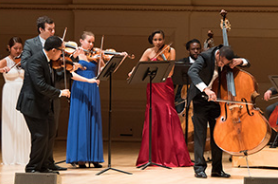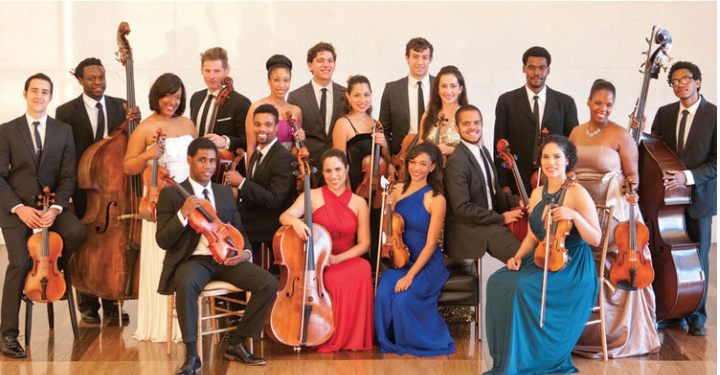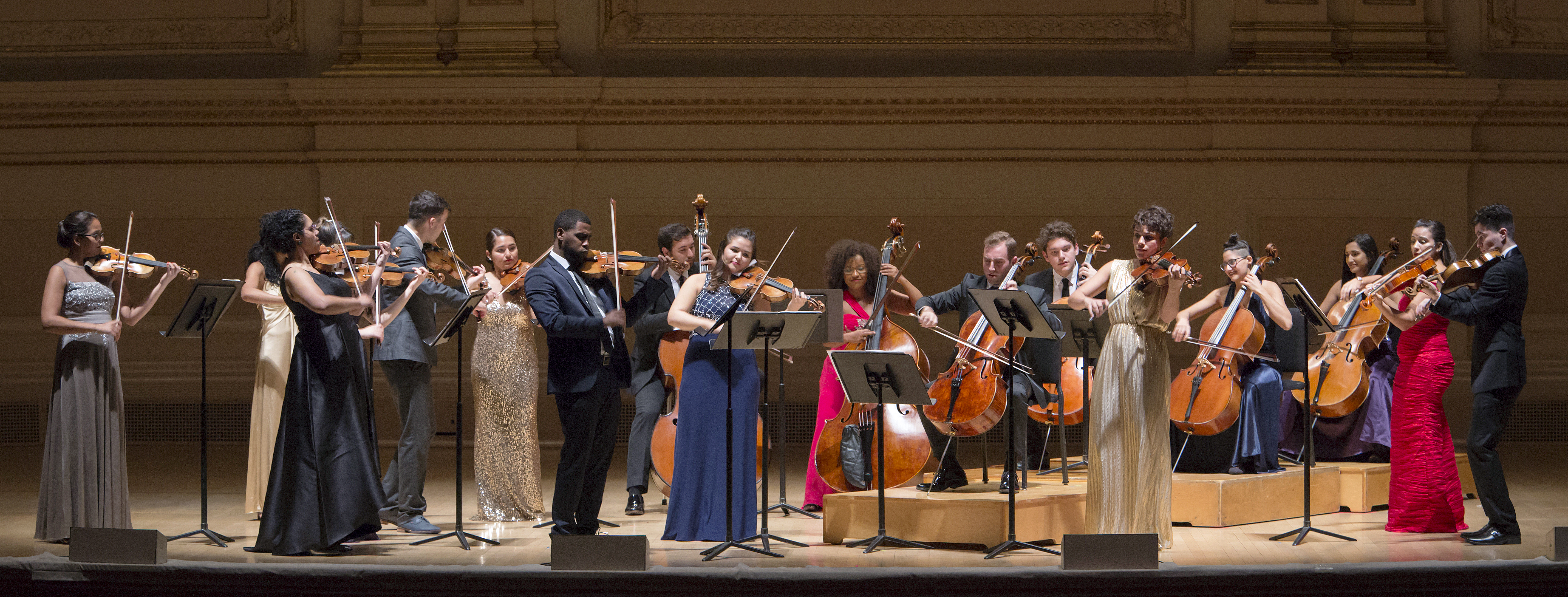Sphinx Virtuosi Concerti per Venti
Stern Auditorium at Carnegie Hall, New York, NY
October 13, 2017
The atmosphere was jubilant in Carnegie Hall’s Stern Auditorium for a recital by the Sphinx Virtuosi, a group described in its biographical materials as “eighteen of the nation’s top Black and Latino classical soloists” performing as part of The Sphinx Organization, a Detroit-based national organization dedicated to diversity in the arts.
Volumes could be written about the Sphinx Organization itself, led by the very dynamic Afa S. Dworkin, who was present to say a few words, but let it suffice to say that Sphinx programs reach more than 100,000 students, as well as live and broadcast audiences of more than 2 million annually. The program notes state that “the organization’s founding and mission were informed by the life experiences of Aaron P. Dworkin, who, as a young Black violinist, was acutely aware of the lack of diversity both on stage and in the audience in concert halls.” He founded Sphinx “to address the stark underrepresentation of people of color in classical music.” Not only is his organization now a boon to diversity with special regard to Black and Latino musicians, but it is a boon to classical music as a whole, as one could tell by the large excited audience. A visit to the website www.sphinxmusic.org will confirm the tremendous scope of this organization, including programs bringing instrumental music to public schools, web resources, a specialized academy, assistance programs, a competition, and various ensembles, including a symphony orchestra, and the Sphinx Virtuosi, the conductor-less string orchestra that we heard.
Volumes could also be written about the program we heard, which covered a similarly huge range, from the opening virtuoso violin solo, Paganiniana of Nathan Milstein (1904-1992) to Beethoven’s Grosse Fuge (Op. 133, arr. For String Orchestra) to Vivaldi’s B-flat Concerto for Violin, Cello, and Continuo (RV547), and the commissioned string orchestra pieces by Michael Abels (b. 1962) and Jimmy Lopez (b.1978).
The opening with Milstein’s Paganiniana was a touch of inspiration, as the sight of one unaccompanied young violinist walking onto that great Carnegie stage before a few thousand people seemed a powerful symbol for the Sphinx mission, representing bravery, youthful promise, and how a single soul’s dream can move mountains. Paganiniana is based on Paganini’s 24th Caprice, and because the Caprices are often used for glorified warm-ups, it brings to mind the intense but exciting discipline that is at the base of all free-wheeling artistry, as Sphinx artists undoubtedly experience. The soloist was Annelle Gregory, a highly accomplished young player who seems poised for an exciting career. Her performance had boldness and panache, and though it may not yet rival Milstein’s own rendition for effortless suavity (as he composed it to play at Carnegie Hall in 1945), hers was an assured romp through violinistic minefields. She was met with such enthusiasm that not only could some audience members not wait until the end, but they clapped at several of the big cadences, in one case just about a minute into the piece. There are certainly bigger concerns in the music world than premature applause these days. Ms. Gregory was unfazed and brilliant.
The next work on the program was Beethoven’s thorny Grosse Fuge, originally for string quartet but played here in an arrangement for string orchestra (one guesses by Felix Weingartner, though the arranger was not listed, and this listener knows it mainly from its quartet performances). It struck this listener at first as an unusual choice in a program seemingly designed to draw in a wider audience for classical music – after all, Beethoven was given quite a lot of grief over its dissonance and difficulty for listener and player alike. In fact, though, it turned out to be an astute choice, its craggy counterpoint tackled expertly and dramatizing the skill and intense individual precision of each fugal entry, as well as the fierce collective drive of the ensemble. As many have said before, this piece sounds always “modern” – and here it sounded newer than ever!
Vivaldi’s double concerto which followed seemed quite tame by comparison, but was a good balance. Violinist Annelle Gregory came back onstage alongside cellist Thomas Mesa in what was a fine collaboration with the rest of the ensemble. Mr. Mesa’s playing had a musical intensity that was commanding in every detail and Ms. Gregory, undoubtedly more warmed up after the Paganiniana, relaxed into an even more fully beautiful sound here. They brought very different strengths and personalities to the work. Despite only a few moments where passages were not completely in sync, it was a thoroughly engaging performance.
Especially noteworthy on the program was the New York Premiere of Guardian of the Horizon: Concerto Grosso for Violin, Cello, and Strings (2017) by Peruvian composer Jimmy López. Co-commissioned by Carnegie Hall, New World Symphony, and Sphinx, the work was composed in honor of Sphinx’s 20th anniversary, but it is also a tribute to the composer’s father who passed away in 2016. Its three movements (Riddle, Crossing the Threshold, and Into the Effulgent Light) reflect the composer’s deeply personal feelings about life and death, intertwined with sphinx mythology in ingenious evocations of riddles (through cryptic musical question-and-answer phrases) and suggestions of shimmering light through tremolo string textures in its exquisite third movement. The violinist Adé Williams teamed up with cellist Gabriel Cabezas in the lead musical parts, both absolutely winning as champions of the work. Clearly there is no shortage of stars on the Sphinx roster, and there will be more to hear from these two musicians, as well as from this composer and composition.
The perfect close was chosen for this program, Michael Abels’ Delights and Dances, commissioned by Sphinx for a 2007 performance and understandably back for what may be becoming (one hopes) a “signature” finale. It is an utterly buoyant tour-de-force with elements of jazz, blues, and bluegrass being tossed in seeming improvisation from player to player, both in the orchestra and in the star string quartet. The quartet featured violinists Rainel Joubert and Alexandra Switala, violist Celia Hatton, and cellist Thomas Mesa, all exchanging mounting improvisatory one-upmanship, with the orchestra collaborating. All players were impressive, but the soaring rhapsodic phrases of Rainel Joubert were particularly captivating. The whole performance made one want to hear it again and again.
All in all, this reviewer has not felt so heartened by a group of young musicians since hearing the early recordings of Gustavo Dudamel with the young players from El Sistema, electrically charged performances of as high a caliber as any other professional group, but with the vital energy of a life-and-death mission.
Ms. Dworkin, in describing the Sphinx mission, used a quote by James Baldwin, that “The precise role of the artist, then, is to illuminate that darkness, blaze roads through that vast forest, so that we will not, in all our doing, lose sight of its purpose, which is, after all, to make the world a more human dwelling place.” Sphinx is indeed illuminating that darkness.



